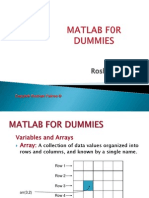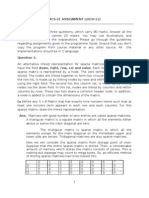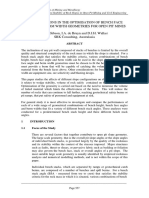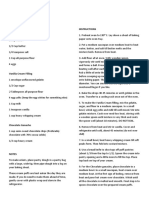0 ratings0% found this document useful (0 votes)
23 viewsSparse Matrices: Matrix Table of Values
Sparse Matrices: Matrix Table of Values
Uploaded by
Sruthy SasiThe document discusses sparse matrices, which are matrices with mostly zero elements. It provides examples of structured sparse matrices where the nonzero elements follow patterns, as well as unstructured sparse matrices like those representing airline routes or web links. To save space, sparse matrices can be stored in a single linear list by only storing the nonzero elements and their indices. This allows efficient operations like matrix transpose and addition using just the nonzero elements.
Copyright:
© All Rights Reserved
Available Formats
Download as PPT, PDF, TXT or read online from Scribd
Sparse Matrices: Matrix Table of Values
Sparse Matrices: Matrix Table of Values
Uploaded by
Sruthy Sasi0 ratings0% found this document useful (0 votes)
23 views19 pagesThe document discusses sparse matrices, which are matrices with mostly zero elements. It provides examples of structured sparse matrices where the nonzero elements follow patterns, as well as unstructured sparse matrices like those representing airline routes or web links. To save space, sparse matrices can be stored in a single linear list by only storing the nonzero elements and their indices. This allows efficient operations like matrix transpose and addition using just the nonzero elements.
Original Title
lec05
Copyright
© © All Rights Reserved
Available Formats
PPT, PDF, TXT or read online from Scribd
Share this document
Did you find this document useful?
Is this content inappropriate?
The document discusses sparse matrices, which are matrices with mostly zero elements. It provides examples of structured sparse matrices where the nonzero elements follow patterns, as well as unstructured sparse matrices like those representing airline routes or web links. To save space, sparse matrices can be stored in a single linear list by only storing the nonzero elements and their indices. This allows efficient operations like matrix transpose and addition using just the nonzero elements.
Copyright:
© All Rights Reserved
Available Formats
Download as PPT, PDF, TXT or read online from Scribd
Download as ppt, pdf, or txt
0 ratings0% found this document useful (0 votes)
23 views19 pagesSparse Matrices: Matrix Table of Values
Sparse Matrices: Matrix Table of Values
Uploaded by
Sruthy SasiThe document discusses sparse matrices, which are matrices with mostly zero elements. It provides examples of structured sparse matrices where the nonzero elements follow patterns, as well as unstructured sparse matrices like those representing airline routes or web links. To save space, sparse matrices can be stored in a single linear list by only storing the nonzero elements and their indices. This allows efficient operations like matrix transpose and addition using just the nonzero elements.
Copyright:
© All Rights Reserved
Available Formats
Download as PPT, PDF, TXT or read online from Scribd
Download as ppt, pdf, or txt
You are on page 1of 19
Sparse Matrices
Matrix table of values
Sparse Matrices
Matrix table of values
0 0 3 0 4
0 0 5 7 0
0 0 0 0 0
0 2 6 0 0
Row 2
Column 4
4 x 5 matrix
4 rows
5 columns
20 elements
6 nonzero elements
Sparse Matrices
Sparse matrix #nonzero elements/#elements
is small.
Examples:
Diagonal
Only elements along diagonal may be nonzero
n x n matrix ratio is n/n
2
= 1/n
Tridiagonal
Only elements on 3 central diagonals may be nonzero
Ratio is (3n-2)/n
2
= 3/n 2/n
2
Sparse Matrices
Lower triangular (?)
Only elements on or below diagonal may be nonzero
Ratio is n(n+1)(2n
2
) ~ 0.5
These are structured sparse matrices. Nonzero
elements are in a well-defined portion of the
matrix.
Sparse Matrices
An n x n matrix may be stored as an n x n array.
This takes O(n
2
) space.
The example structured sparse matrices may be
mapped into a 1D array so that a mapping
function can be used to locate an element
quickly; the space required by the 1D array is
less than that required by an n x n array (next
lecture).
Unstructured Sparse Matrices
Airline flight matrix.
airports are numbered 1 through n
flight(i,j) = list of nonstop flights from airport i
to airport j
n = 1000 (say)
n x n array of list pointers => 4 million bytes
total number of nonempty flight lists = 20,000
(say)
need at most 20,000 list pointers => at most
80,000 bytes
Unstructured Sparse Matrices
Web page matrix.
web pages are numbered 1 through n
web(i,j) = number of links from page i to page j
Web analysis.
authority page page that has many links to it
hub page links to many authority pages
Web Page Matrix
n = 2 billion (and growing by 1 million a day)
n x n array of ints => 16 * 10
18
bytes (16 * 10
9
GB)
each page links to 10 (say) other pages on
average
on average there are 10 nonzero entries per row
space needed for nonzero elements is
approximately 20 billion x 4 bytes = 80 billion
bytes (80 GB)
Representation Of Unstructured
Sparse Matrices
Single linear list in row-major order.
scan the nonzero elements of the sparse matrix in row-
major order (i.e., scan the rows left to right
beginning with row 1 and picking up the nonzero
elements)
each nonzero element is represented by a triple
(row, column, value)
the list of triples is stored in a 1D array
Single Linear List Example
0 0 3 0 4
0 0 5 7 0
0 0 0 0 0
0 2 6 0 0
list =
row 1 1 2 2 4 4
column 3 5 3 4 2 3
value 3 4 5 7 2 6
One Linear List Per Row
0 0 3 0 4
0 0 5 7 0
0 0 0 0 0
0 2 6 0 0
row1 = [(3, 3), (5,4)]
row2 = [(3,5), (4,7)]
row3 = []
row4 = [(2,2), (3,6)]
Single Linear List
Array representation
1D Array of triples of type term
int row, col, value
Size of 1D array generally not predictable at
time of initialization.
Start with some default capacity/size (say 10)
Increase capacity as needed
Use REALLOC
Approximate Memory Requirements
500 x 500 matrix with 1994 nonzero elements, 4
bytes per element
2D array 500 x 500 x 4 = 1million bytes
1D array of triples 3 x 1994 x 4
= 23,928 bytes
Matrix Transpose
0 0 3 0 4
0 0 5 7 0
0 0 0 0 0
0 2 6 0 0
0 0 0 0
0 0 0 2
3 5 0 6
0 7 0 0
4 0 0 0
Matrix Transpose
2 3 3 3 4 5
4 1 2 4 2 1
2 3 5 6 7 4
row 1 1 2 2 4 4
column 3 5 3 4 2 3
value 3 4 5 7 2 6
0 0 3 0 4
0 0 5 7 0
0 0 0 0 0
0 2 6 0 0
0 0 0 0
0 0 0 2
3 5 0 6
0 7 0 0
4 0 0 0
Matrix Transpose
row 1 1 2 2 4 4
column 3 5 3 4 2 3
value 3 4 5 7 2 6
0 0 3 0 4
0 0 5 7 0
0 0 0 0 0
0 2 6 0 0
0 0 0 0
0 0 0 2
3 5 0 6
0 7 0 0
4 0 0 0
Step 1: #nonzero in each row of transpose.
= #nonzero in each column of
original matrix
= [0, 1, 3, 1, 1]
Step2: Start of each row of transpose
= sum of size of preceding rows of
transpose
= [0, 0, 1, 4, 5]
Step 3: Move elements, left to right, from
original list to transpose list.
Matrix Transpose
Step 1: #nonzero in each row of transpose.
= #nonzero in each column of
original matrix
= [0, 1, 3, 1, 1]
Step2: Start of each row of transpose
= sum of size of preceding rows of
transpose
= [0, 0, 1, 4, 5]
Step 3: Move elements, left to right, from
original list to transpose list.
Complexity
m x n original matrix
t nonzero elements
Step 1: O(n+t)
Step 2: O(n)
Step 3: O(t)
Overall O(n+t)
Runtime Performance
Matrix Transpose
500 x 500 matrix with 1994 nonzero elements
Run time measured on a 300MHz Pentium II PC
2D array 210 ms
SparseMatrix 6 ms
Performance
Matrix Addition.
500 x 500 matrices with 1994 and 999 nonzero
elements
2D array 880 ms
SparseMatrix 18 ms
You might also like
- NumPy NotesDocument13 pagesNumPy Notessiddhant bhandariNo ratings yet
- Past Year Q For Wireman 1Document18 pagesPast Year Q For Wireman 1陈系铭100% (1)
- Aae 251 Final Design Project Team pm13Document23 pagesAae 251 Final Design Project Team pm13api-278596732No ratings yet
- Sparse Matrices: Matrix Table of ValuesDocument21 pagesSparse Matrices: Matrix Table of Valuestest testNo ratings yet
- Sparse Matrices: Matrix Table of ValuesDocument19 pagesSparse Matrices: Matrix Table of ValuesDeepak Kumar MehtaNo ratings yet
- MatlabDocument29 pagesMatlabRoshan Patroo100% (2)
- Lec11 BDocument25 pagesLec11 BNilesh ChaudharyNo ratings yet
- IGNOU MCA MCS-21 Solved Assignments 2011Document17 pagesIGNOU MCA MCS-21 Solved Assignments 2011Syedkareem_hkgNo ratings yet
- 3.1 Arrays and MatricesDocument33 pages3.1 Arrays and MatricesKoskei VicNo ratings yet
- Module 2 Part1 ArrayMatricsDocument37 pagesModule 2 Part1 ArrayMatricsMohitMangglamNo ratings yet
- NumpyDocument44 pagesNumpySaif JuttNo ratings yet
- Arrays and Matrices: Shameer A KoyaDocument33 pagesArrays and Matrices: Shameer A KoyaJosh HukshiamNo ratings yet
- Addressing Modes Example Instruction Meaning When Used: Complexity and Big-O NotationDocument7 pagesAddressing Modes Example Instruction Meaning When Used: Complexity and Big-O NotationAbhisek SarkarNo ratings yet
- Matrix and GraphDocument44 pagesMatrix and GraphAbhik DasguptaNo ratings yet
- NumPy QuickstartDocument26 pagesNumPy QuickstartflcwkNo ratings yet
- CSC-HC-3016 Data Structures Unit IDocument5 pagesCSC-HC-3016 Data Structures Unit ICSC LCBNo ratings yet
- Data Structure & Algorithms: ArraysDocument42 pagesData Structure & Algorithms: ArraysBicinNo ratings yet
- Sparse Matrices: Sparse Many Elements Are Zero Dense Few Elements Are ZeroDocument21 pagesSparse Matrices: Sparse Many Elements Are Zero Dense Few Elements Are ZeroSeema MongiaNo ratings yet
- Week 12 - Lecture Notes Special MatricesDocument25 pagesWeek 12 - Lecture Notes Special MatricesFarheen NawaziNo ratings yet
- Data Analytics NumpyDocument27 pagesData Analytics NumpyVivek MunjayasraNo ratings yet
- PythonDocument372 pagesPythonMaTi UR ReHmanNo ratings yet
- DS - ArraysDocument67 pagesDS - Arrayskalash satypalNo ratings yet
- Notes PythonDocument93 pagesNotes PythonRobert CullenNo ratings yet
- Lec 10Document24 pagesLec 10bdebbarmaNo ratings yet
- Data Structures Using C (Csit124) Lecture Notes: by Dr. Nancy GirdharDocument42 pagesData Structures Using C (Csit124) Lecture Notes: by Dr. Nancy GirdharINDIAN REMIXNo ratings yet
- Ap19110010321 - JanithDocument6 pagesAp19110010321 - JanithSaijanith PNo ratings yet
- DS 4Document15 pagesDS 4Ahmad BajwaNo ratings yet
- DSP Lab 1 Fall 20.PDF NEWDocument12 pagesDSP Lab 1 Fall 20.PDF NEWChayon ImeuNo ratings yet
- R Programming Cse I & IIDocument59 pagesR Programming Cse I & II228a1a0558No ratings yet
- Array NotesDocument11 pagesArray Notessatya2891No ratings yet
- Multi Dimensional ArraysDocument25 pagesMulti Dimensional Arraystjames445No ratings yet
- Tentative NumPy TutorialDocument30 pagesTentative NumPy TutoriallsunusNo ratings yet
- Is5312 Week10-V2Document51 pagesIs5312 Week10-V2lengbiao111No ratings yet
- Imran Rasool Bbe-1586Document9 pagesImran Rasool Bbe-1586M shahzaibNo ratings yet
- Number System and Logic GatesDocument137 pagesNumber System and Logic GatesAbhishek SataleNo ratings yet
- Non-Activated Version: ArrayDocument9 pagesNon-Activated Version: ArraymohamedNo ratings yet
- ASSIGNMENT PROBLEM (Hungarian Method)Document16 pagesASSIGNMENT PROBLEM (Hungarian Method)Seerat FatimaNo ratings yet
- DS - Radix Sort (8) - SLMDocument5 pagesDS - Radix Sort (8) - SLMm.biswas2014.mbNo ratings yet
- Linear RegressionDocument14 pagesLinear RegressionSaad AhmedNo ratings yet
- Week 3-Multidimensional Array Concepts, Searching SortingDocument44 pagesWeek 3-Multidimensional Array Concepts, Searching SortingSmokeyNo ratings yet
- Sorting, Ranking, Indexing, Selecting: I R S I RDocument8 pagesSorting, Ranking, Indexing, Selecting: I R S I RDon HoNo ratings yet
- Analitical ReseachDocument15 pagesAnalitical Reseachemir taşçıNo ratings yet
- 4 ArraypptDocument18 pages4 Arraypptcimolep225No ratings yet
- AP19110010420 - VenkatrajaDocument6 pagesAP19110010420 - VenkatrajaSaijanith PNo ratings yet
- Matlab BasicsDocument30 pagesMatlab BasicsTewodrosNo ratings yet
- Multidimensional Arrays: Processing Sequences of ElementsDocument42 pagesMultidimensional Arrays: Processing Sequences of ElementsAnita SupramaniamNo ratings yet
- Example:: (A Complete Solution Site)Document9 pagesExample:: (A Complete Solution Site)Naveen ChandraNo ratings yet
- Lecture Note #4Document31 pagesLecture Note #4mohammed.cragpd7710No ratings yet
- Chapter 2Document28 pagesChapter 2PM 2014 1st year summer studentsNo ratings yet
- Week 2-Arrays-UpdatedDocument40 pagesWeek 2-Arrays-Updatedlama alessaNo ratings yet
- ANL252 SU3 Jul2022Document23 pagesANL252 SU3 Jul2022EbadNo ratings yet
- HKU - 7001 - 3.2 Managing Data IIDocument67 pagesHKU - 7001 - 3.2 Managing Data IIloNo ratings yet
- 07 GENN004m MatricesDocument9 pages07 GENN004m MatricesBishoy EmileNo ratings yet
- Unit 2 - Lecture 1 - Multidimensional Arrays - Applications of ArraysDocument19 pagesUnit 2 - Lecture 1 - Multidimensional Arrays - Applications of ArraysNirmala KumariNo ratings yet
- ArrayDocument9 pagesArrayAfsal PesworldNo ratings yet
- Arrays in Python & C++Document52 pagesArrays in Python & C++kiettelNo ratings yet
- AlgorithmsDocument13 pagesAlgorithmsjuhi2781No ratings yet
- Arrays in PythonDocument52 pagesArrays in PythonAman Singh Raghuwanshi100% (1)
- Matrix OperationsDocument21 pagesMatrix Operationspoojaguptaindia1No ratings yet
- Python in 90 MinutesDocument53 pagesPython in 90 Minutesshyed20012721No ratings yet
- Matrices with MATLAB (Taken from "MATLAB for Beginners: A Gentle Approach")From EverandMatrices with MATLAB (Taken from "MATLAB for Beginners: A Gentle Approach")Rating: 3 out of 5 stars3/5 (4)
- Advanced C Concepts and Programming: First EditionFrom EverandAdvanced C Concepts and Programming: First EditionRating: 3 out of 5 stars3/5 (1)
- Chapter 3 - Combinational Logic DesignDocument37 pagesChapter 3 - Combinational Logic DesignSruthy SasiNo ratings yet
- Minimum Spanning Trees: Prim's Algorithm Kruskal's AlgorithmDocument33 pagesMinimum Spanning Trees: Prim's Algorithm Kruskal's AlgorithmSruthy SasiNo ratings yet
- Daa QB 1 PDFDocument24 pagesDaa QB 1 PDFSruthy SasiNo ratings yet
- Design and Analysis of Algorithm PDFDocument4 pagesDesign and Analysis of Algorithm PDFSruthy SasiNo ratings yet
- Paedodontics 2001-2012Document42 pagesPaedodontics 2001-2012Sruthy SasiNo ratings yet
- Conservative Dentistry and Endodontics 2001-2012Document32 pagesConservative Dentistry and Endodontics 2001-2012Sruthy SasiNo ratings yet
- Oral Surgery 2001-2011Document42 pagesOral Surgery 2001-2011Sruthy SasiNo ratings yet
- Algorithms: 1.1 Algorithm SpecificationDocument22 pagesAlgorithms: 1.1 Algorithm SpecificationSruthy SasiNo ratings yet
- Unit - 3: Dr. P. Sudhakara Rao, Dean Switching Theory and Logic DesignDocument18 pagesUnit - 3: Dr. P. Sudhakara Rao, Dean Switching Theory and Logic Designswathich6No ratings yet
- Computer Programming: Control StatementsDocument14 pagesComputer Programming: Control StatementsSruthy SasiNo ratings yet
- R 403 Object OrientedDocument4 pagesR 403 Object OrientedSruthy SasiNo ratings yet
- Year Gone by 2011Document12 pagesYear Gone by 2011Sruthy SasiNo ratings yet
- Form No.1 Birth ReportDocument4 pagesForm No.1 Birth ReportSruthy SasiNo ratings yet
- Model No.: SC + R9: RF 2.4G RGB/RGBW LED SPI Controller SetDocument4 pagesModel No.: SC + R9: RF 2.4G RGB/RGBW LED SPI Controller SetkujaautumnNo ratings yet
- Fire and Explosion PDFDocument96 pagesFire and Explosion PDFanpuselvi125100% (1)
- From Hand To MouthDocument8 pagesFrom Hand To MouthAbigail MirabelNo ratings yet
- Functions of The Passive VoiceDocument6 pagesFunctions of The Passive VoiceAl HabsiNo ratings yet
- Ka MantraDocument3 pagesKa Mantrar.saivengadaramananNo ratings yet
- Robocupjunior Rescue Line - Rules 2016: ScenarioDocument16 pagesRobocupjunior Rescue Line - Rules 2016: ScenarioJhilver Quispe BarrazaNo ratings yet
- Winter 2023 Experiment CatalogDocument20 pagesWinter 2023 Experiment CatalogThe Experiment100% (1)
- Shelf Life Extension of CheeseDocument18 pagesShelf Life Extension of Cheesenils2484100% (1)
- Diagnostic Approach of Dyspepsia SyndromeDocument20 pagesDiagnostic Approach of Dyspepsia SyndromeYaniNo ratings yet
- Perstorp 2Document29 pagesPerstorp 2Louis Luiz0% (1)
- The Kefir Manual: Want To Learn More About Kefir? It's All HereDocument24 pagesThe Kefir Manual: Want To Learn More About Kefir? It's All HereMarcley Oliveira50% (2)
- Considerations in The Optimisation of Bench Face Angle and Berm Width Geometries For Open Pit MinesDocument22 pagesConsiderations in The Optimisation of Bench Face Angle and Berm Width Geometries For Open Pit MinesPaula OliveiraNo ratings yet
- Directorate of Vocational Education and Training,: ITI Directory - Centralise Admission in Year 2020-21Document63 pagesDirectorate of Vocational Education and Training,: ITI Directory - Centralise Admission in Year 2020-21Ajay BhondaveNo ratings yet
- Directions: For Each of The Questions Below, ONE or MORE of The Responses Is (Are) Correct. Decide Which of TheDocument5 pagesDirections: For Each of The Questions Below, ONE or MORE of The Responses Is (Are) Correct. Decide Which of TheNhicoyChuaNo ratings yet
- Satellite Pro L300D-SP5801Document4 pagesSatellite Pro L300D-SP5801SPIN2018100% (1)
- Webinar - Micro Motion 4200 Coriolis TransmitterDocument19 pagesWebinar - Micro Motion 4200 Coriolis TransmittermedicalbillingspamNo ratings yet
- Chocolate Profiteroles: Michael's KitchenDocument1 pageChocolate Profiteroles: Michael's KitchenMikesKitchenNo ratings yet
- Oilpaint Weebly EdDocument22 pagesOilpaint Weebly Edapi-293964578No ratings yet
- Plano Hidraulico d8tDocument2 pagesPlano Hidraulico d8tJonathan HenriNo ratings yet
- Navi Mumbai Special Economic Zone (NM Sez) " A Global Sez"Document59 pagesNavi Mumbai Special Economic Zone (NM Sez) " A Global Sez"kc wardhaNo ratings yet
- Physical Science ReportDocument35 pagesPhysical Science Reportadrian lozanoNo ratings yet
- First Topic - PMLSDocument18 pagesFirst Topic - PMLSSymonette OcturaNo ratings yet
- AYMOD KATALOG DIJITAL SmallDocument154 pagesAYMOD KATALOG DIJITAL SmalljmodelskiNo ratings yet
- English Grammar Nouns Worksheet 5th Grade NTSEDocument2 pagesEnglish Grammar Nouns Worksheet 5th Grade NTSESuvashreePradhan50% (2)
- Introduction To Philosophy of The Human NatureDocument44 pagesIntroduction To Philosophy of The Human NatureButterfly Fashion100% (1)
- Applied Mechanics Civil Booster UpdatedDocument33 pagesApplied Mechanics Civil Booster Updatedusha2.dahikarNo ratings yet
- Group 2Document6 pagesGroup 2Muhammad Asim RazaNo ratings yet





































































































